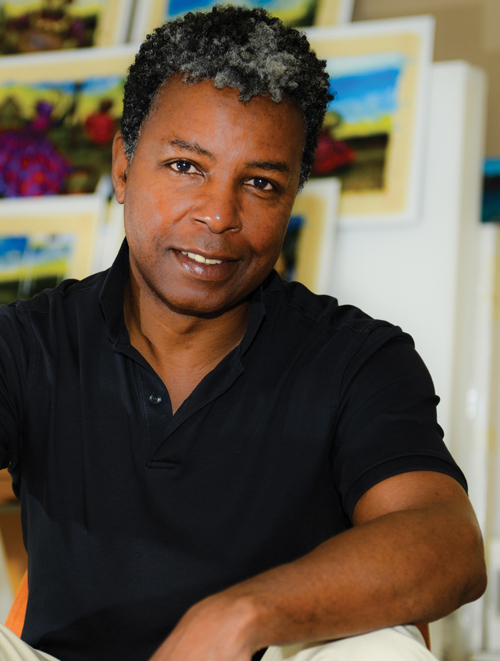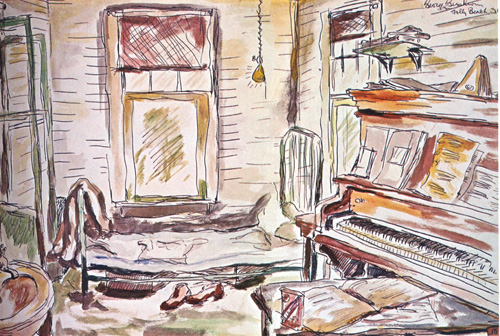
“When Director Marybeth Clark and I began working on this newest version of Gershwin at Folly, we wanted a way to graphically illustrate that Gershwin’s coming to Folly Beach was like coming to another world-a truly magical and exotic world,” explains playwright, Julian Wiles. “Gershwin himself, in a letter to his mother said arriving on Folly was as if he had ‘landed on a battered South Sea Island.’ Folly was indeed fairly primitive in those days, there was no bridge and you had to bring your own fresh water with you. What better way to illustrate Gershwin’s discovery of the exotic and still wild South Carolina Lowcountry than through the art of renowned Gullah artist Jonathan Green. Jonathan had painted the stunning Grand Show Curtain for our return to the Dock Street in 2010 so it seemed a natural fit to ask him to become involved in this project. Jonathan quickly and enthusiastically agreed.”
“What drew me to this project was the cultural inclusion of Julian’s script as it tells the amazing story of Gershwin discovering and embracing the rich Gullah Culture of the South Carolina Lowcountry,” notes Jonathan Green. “I was impressed at how the play shows how the lives of the people of the Lowcountry have been intertwined for generations-their music, their culture, their way of life. I was excited to be able to use my talents to add a visual reflection of the life and times of the people of the Lowcountry during Gershwin’s historic visit. Just as Gershwin used his musical talents to celebrate and immortalize the rich and vibrant culture of the South Carolina Lowcountry, I set out to capture the color and light and vibrancy of the Gullah world of 1934. Through my paintings and sketches I put that world up on stage-joining Julian and his cast in celebrating this special moment in Lowcountry cultural history.” Jonathan began by reading the script, but he didn’t just read it-he made elaborate pencil sketches in the margins, soon filling the pages with delightful drawings from cover to cover-more than 50 of them. Next, Jonathan painted five small paintings to illustrate key scenes in the play. He made colorful and fanciful renditions of Gershwin’s cottage on Folly, dancers at the Indigo Club, a juke joint, a gospel filled church, a beautiful beach, a marsh landscape and more.

Next, it fell to Charleston Stage’s Resident Scenic Designer Ken Barnett to translate Jonathan’s work into actual scenery. “The first thing we did,” explained Barnett, “was to make things three-dimensional. Our main set, which we call ‘Jonathan Green-Land’ features clouds (drawn from Jonathan’s paintings) floating in the air, and cut out palmetto trees that appear from left and right. Upstage there are sand dunes and a beautiful multicolored ocean-cape that finishes out this 3-D rendering of Jonathan’s work. Some scenic elements such as Gershwin’s beach cottage came directly from his painting, others we adapted from the pencil drawings Jonathan did in the margins of the script. Like the Gershwin family, who allowed Julian to draw on any and all of Gershwin’s music, Jonathan generously allowed us to use elements from his other paintings as well. For instance, there’s a wonderful oak tree that we are using from Jonathan’s painting called ‘Tales’ (1998).”

Charleston Stage Resident Costumer Barbara Young was charged with adapting characters from Jonathan’s artwork into costumes that actors could actually wear. “With such a wealth of color and patterns in Jonathan’s art,” said Young, “Jonathan gave us many possibilities to work with. We sought out fabrics that reflected the bold patterns of his characters, copied those wonderful hats he creates and more. Like Ken, we drew both from Jonathan’s paintings and from the delightful character sketches he created in the margins of the script. It’s been fun.”
Combining art and music and Folly Beach is nothing new. When Gershwin himself arrived on Folly Beach he arrived with his artist cousin, Henry Botkin, who painted a number of canvases during his stay. Botkin had studied in Paris and had helped Gershwin build an impressive personal art collection which included works by Gauguin, Kandinsky and Chagall. Thanks to Botkin, we have a watercolor sketch of the cottage Gershwin stayed in that summer. Gershwin, himself, was an accomplished painter and while on Folly created a watercolor sketch of his Folly Beach studio. This watercolor shows his iron bed, a single light bulb hanging overhead and the piano Gershwin rented to begin his work on Porgy and Bess.

Across the street from Gershwin’s cottage was the cottage owned by his hosts, Dorothy and DuBose Heyward. The Heywards had purchased their beach house with funds DuBose had earned writing screenplays in Hollywood, so they dubbed their beach house “Follywood”. This house still stands and has been lovingly restored by Myles and Kathy Glick.
“I think Gershwin would be pleased that we’ve combined the art of the Lowcountry in telling the story of his Folly Beach sojourn,” says playwright Wiles. “Gershwin himself embraced a wide range of artistic and musical styles and his compositions certainly reflect this, ranging from classical to jazz to the indigenous spirituals and music of the Gullah culture he discovered on nearby James Island. Gershwin at Folly, using the vibrant colors and whimsy of Jonathan Green’s art, celebrates Gershwin’s merging of art and cultures-the creative whirlwind that gave us, and the world, Porgy and Bess.”
